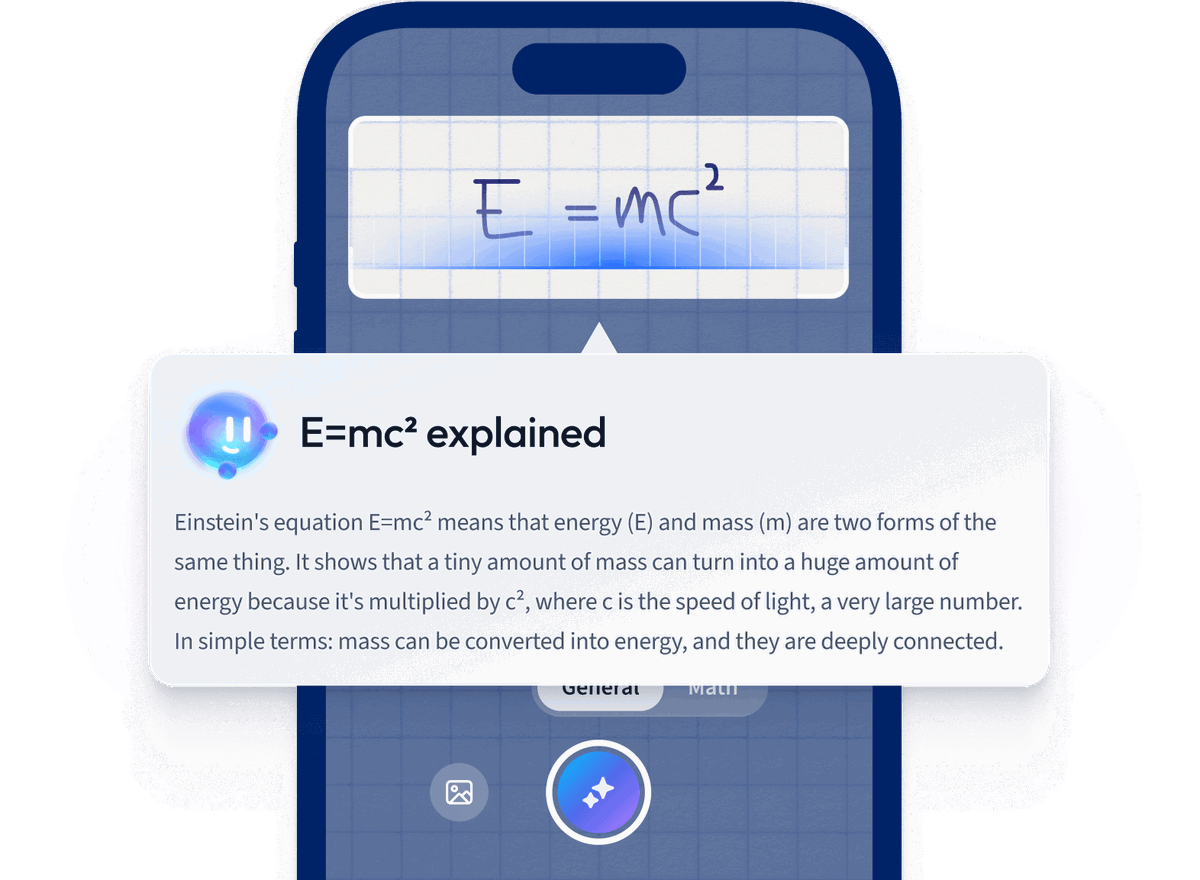- This article focuses on mass-energy conversion.
- First, we will look at Einstein's mass-conversion equation.
- Next, we will use this equation in an example.
- After that, we will look at radioactive decay reaction and calculate how much energy is released during one.
- Then, we will look at the mass-energy conversion that happens in the sun called solar fusion.
- Lastly, we will look at the mass-energy conversion that occurs when an atomic bomb explodes.
Einstein's Mass-Energy Conversion Equation
So let's take a closer look at that equation, shall we?
$$E=mc^2$$
Where:
- E is energy,
- m is mass
- c is the speed of light.
The key point here is that all objects have an intrinsic amount of energy stored within them. The speed of light is a pretty large number (approximately 3x108 m/s), so even a small particle can have a lot of energy stored within it.
To understand what I mean, let's look at an example.
Mass-Energy Conversion example
Let's say we have a cute tuxedo cat that is 3.63 kg (about 8 pounds). How much energy does this cat contain? Well, let’s plug it into our formula:
$$E=mc^2$$
$$E=(3.63\,kg)(3x10^8\frac{m}{s})^2$$
$$E=(3.63\,kg)(9x10^{16}\frac{m^2}{s^2})$$
$$E=3.267x10^17\frac{kg*m^2}{s^2}$$
$$1\,Joule(J)=1\frac{kg*m^2}{s^2}$$
$$E=3.267x10^17\,J$$
For reference, an atomic bomb releases about 1.5·1013 joules, so this is about 22,000 times stronger than that.
While you may now be side-eyeing your furry friend, it isn't actually a ticking time bomb. In reality, it's pretty hard to convert that mass into energy, which is why nuclear weapons are used in warfare instead of cats (or equally heavy objects).
Matter-Antimatter Annihilation
It's incredibly difficult to release all of a species' energy. The only way to do so would be through annihilation. This is a process where the matter and antimatter collide and release all that energy through electromagnetic waves.
For example, if an electron (-e) and a positron (+e) collide, they will annihilate each other and release the stored energy through gamma rays.
Basically, these two species "cancel themselves out" which releases all the stored energy in the matter. However, this process is very uncommon as there isn't much antimatter around.
Mass-Energy Conversion Reaction
One of the ways mass is converted to energy is through radioactive decay.
During radioactive decay, an unstable nucleus gives off radiation in the form of energy and/or particles to become more stable
We can use the mass-energy conversion equation to calculate the energy emitted due to the loss of mass through particle emission.
For example, let's calculate the energy loss due to this reaction:
 Fig.1-Radioactive decay of cesium
Fig.1-Radioactive decay of cesium
Here we see the decay of a cesium (Cs) atom. It converts one of its neutrons (n) into a proton (p+) and an electron (e-), which is ejected. Since the species is gaining a proton, it becomes barium (Ba).
Every element has a set number of protons called an atomic number. When the atomic number changes (i.e, the number of protons changes), the identity of the element changes,
First, we need to calculate the change in mass. We are going from a radioactive cesium-137 sample (mass 136.907 g/mol) to a neutral barium-137 sample (136.906 g/mol). So the change in mass is:
$$\Delta m=m_{product}-m_{reactant}$$
$$\Delta m=(136.906\frac{g}{mol})-(136.907\frac{g}{mol})$$
$$\Delta m=-0.001\frac{g}{mol}$$
If we assume that there is 1 mol of the sample, there is a -0.001 g or -1x10-6 kg change in mass.
Now we can plug this into our mass-energy conversion formula:
$$\Delta E=\Delta m*c^2$$
$$\Delta E=(-1x10^{-6}\,kg)(3x10^8\frac{m}{s})^2$$
$$\Delta E=-9x10^{10}\,J$$
The amount of energy released here is much, much greater than that of a standard chemical reaction.
Mass-Energy Conversion in the Sun
Have you ever wondered how the sun produces energy? The answer is nuclear fusion.
Nuclear fusion is the process where smaller atomic nuclei combine to form a heavier nucleus, releasing energy in the process.
 Fig.2-Solar nuclear fusion
Fig.2-Solar nuclear fusion
Basically, there are several collisions to make heavier and heavier nuclei until we form the stable helium nucleus (which has 2 protons and 2 neutrons).Now let's do our calculation!In the sun, four hydrogen nuclei fuse to form helium nuclei. If the total mass of the four hydrogen nuclei is 4.03130 amu and the mass of a hydrogen nucleus is 4.00268, what is the total energy amount released?
$$\Delta m=m_{product}-m_{reactants}$$
$$\Delta m=(4.00268\,amu)-(4.03130\,amu)$$
$$\Delta m=-0.02862\,amu$$
Assuming that there is 1 mol of the reactants, the mass change is -0.02862 g or -2.862x10-5 kg
$$\Delta E=\Delta mc^2$$
$$\Delta E=(-2.862x10^{-5}\,kg)(3x10^{8}\frac{m}{s})^2$$
$$\Delta E=2.58x10^12\,J$$
That's a lot of energy!!
Mass Energy conversion in Atomic Bomb
Atomic bombs work due to a different process called nuclear fission.
Nuclear fission is the process of splitting a nucleus, which releases energy
The way an atomic bomb works is through a chain fission reaction:
- A free neutron strikes the nucleus of a radioactive element (ex: uranium).
- The strike knocks off a few neutrons from the radioactive nucleus.
- These now free neutrons strike other nuclei, releasing more energy/neutrons.
This chain reaction kicks off almost instantaneously, which is why so much energy is released.
While the bombs themselves are massive, the mass change is a lot smaller. For example, one atomic bomb that weighed about 1.86x107 kilograms only converted 0.9 grams of it into energy.
While that may seem small in theory, let's calculate the energy released.
Calculate the energy released when an atomic bond converts 0.9 grams (9x10-4 kg) into energy:
$$\Delta E=\Delta m*c^2$$
$$\Delta E=(9x10^{-4}\,kg)(3x10^8\frac{m}{s})^2
$$\Delta E=8.1x10^{13}\,J$$
For reference, that would be like if you set off over 22,000 tons of TNT.
Mass-Energy Conversion - Key takeaways
- The equation for mass-energy conversion is: $$E=mc^2$$
- Where E is energy, m is mass, and c is the speed of light
- Mass is usually converted to energy through a nuclear or radioactive reaction
- During radioactive decay, an unstable nucleus gives off radiation in the form of energy and/or particles to become more stable
- Nuclear fusion is the process where smaller atomic nuclei combine to form a heavier nucleus, releasing energy in the process.
- Nuclear fission is the process of splitting a nucleus, which releases energy
References
- Fig.1-Radioactive decay of cesium (https://upload.wikimedia.org/wikipedia/commons/thumb/b/bd/Beta-decay-example.svg/640px-Beta-decay-example.svg.png) by MikeRun on Wikimedia Commons licensed by CC BY-SA 4.0 (https://creativecommons.org/licenses/by-sa/4.0/)
- Fig.2-Solar nuclear fusion (https://upload.wikimedia.org/wikipedia/commons/thumb/7/78/Fusi%C3%B3n_solar.png/640px-Fusi%C3%B3n_solar.png) by Borb on Wikimedia Commons (https://commons.wikimedia.org/wiki/User:Borb) licensed by CC BY-SA 3,0 (https://creativecommons.org/licenses/by-sa/3.0/deed.en)
How we ensure our content is accurate and trustworthy?
At StudySmarter, we have created a learning platform that serves millions of students. Meet
the people who work hard to deliver fact based content as well as making sure it is verified.
Content Creation Process:
Lily Hulatt is a Digital Content Specialist with over three years of experience in content strategy and curriculum design. She gained her PhD in English Literature from Durham University in 2022, taught in Durham University’s English Studies Department, and has contributed to a number of publications. Lily specialises in English Literature, English Language, History, and Philosophy.
Get to know Lily
Content Quality Monitored by:
Gabriel Freitas is an AI Engineer with a solid experience in software development, machine learning algorithms, and generative AI, including large language models’ (LLMs) applications. Graduated in Electrical Engineering at the University of São Paulo, he is currently pursuing an MSc in Computer Engineering at the University of Campinas, specializing in machine learning topics. Gabriel has a strong background in software engineering and has worked on projects involving computer vision, embedded AI, and LLM applications.
Get to know Gabriel













